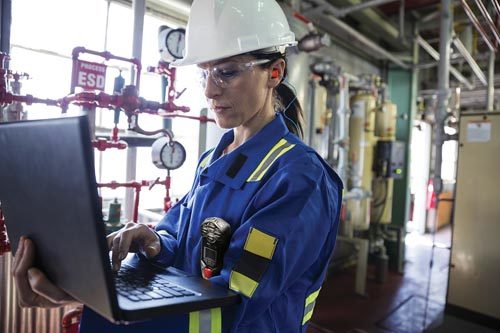Data collection and worker privacy
Data analytics has a lot to offer on an industrial worksite from an efficiency, safety and cost-savings perspective. But, my employees are concerned with the level of data collection this requires and their privacy. How can I address this?

Responding is Brendon Cook, chief partnership officer, Blackline Safety, Calgary, Alberta.
Businesses and enterprises are undergoing digital transformation, driven by connectivity and data. Data analytics combines and processes data from multiple sources to make fact-based decisions that boost safety, quality and efficiency. On industrial worksites, data is often collected through employee wearable devices such as gas detectors or lone worker monitors. It can be combined with information from other systems, such as environmental, health and safety; scheduling; and billing software.
Through data, safety professionals can better visualize a situation, objectively identify a problem and develop a well-informed solution. Going one step further, analyzing worksite data helps predict future events and mitigate safety incidents. It can also be used to optimize operations. For example, data can be used to proactively schedule supervision of projects to ensure efficient and safe operations. In gas detection, it provides insight into whether employees are bump testing and calibrating their gas sensors at the frequency required for regulatory compliance. Another use is to examine the movement of personnel through worksites to optimize the location of tool cribs, cool-down trailers and other infrastructure.
When it comes to privacy, it’s not uncommon for employees at some businesses to be apprehensive about data collection. Location data, in particular, can be a point of concern, and depending on location-reporting settings, it can document where employees operate and contribute to make inferences about their activities. Personnel may have a concern that this data could be misused or used punitively by the company.
Organizations can take several steps to ease concerns from its workforce.
The first step a company should take when collecting large amounts of data is to determine a plan for how to store and use it. This plan should be developed in collaboration with the company’s legal, human resources and information technology departments. Legal counsel can advise on best practices for data collection and use, including how to best protect employees and navigate trust or privacy issues. IT personnel can advise on how to best store and recall data securely so it’s not vulnerable to hackers or other security threats.
To further protect the privacy of employees, controls are available that allow safety pros to monitor employee safety anonymously via a pool of shared devices. As a different employee is using a different device each shift, this eliminates the connection to a particular individual, also allowing for more frequent location reporting intervals, which can help with achieving accurate data insights.
Another course of action is to develop a corporate policy, or an agreement with a union, that this data will not be used for punitive purposes.
Lastly, companies should limit access to this data to only necessary personnel. This is normally managed through strict user access controls. While some users can administer groups of equipment, others can respond to alerts – all while keeping tight access to information. Only key personnel are provided access to the full pool of available data.
Finally, an important component of successfully implementing connected technology and data analytics on a worksite is employee education and communication. Companies should put significant effort into educating their teams on the purpose of deploying this technology and how it will be used. Employees should feel secure that the company is using this data with the ultimate objective of keeping them safe while increasing the business’s competitiveness, quality and efficiency. When an organization proactively educates its workforce on the purpose of wearing devices of this nature, it will typically see a higher compliance rate as well as stronger employee morale.
Editor's note: This article represents the independent views of the authors and should not be construed as a National Safety Council endorsement.
Post a comment to this article
Safety+Health welcomes comments that promote respectful dialogue. Please stay on topic. Comments that contain personal attacks, profanity or abusive language – or those aggressively promoting products or services – will be removed. We reserve the right to determine which comments violate our comment policy. (Anonymous comments are welcome; merely skip the “name” field in the comment box. An email address is required but will not be included with your comment.)

